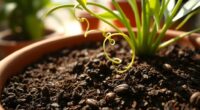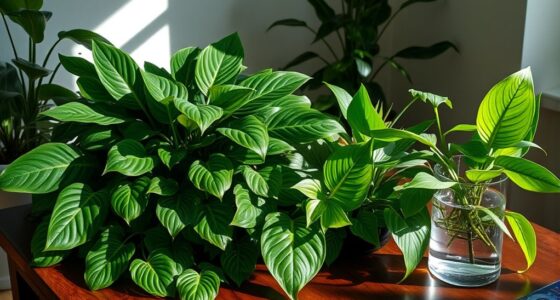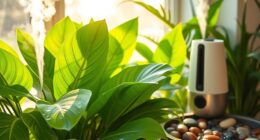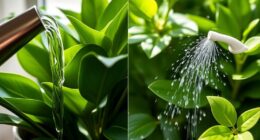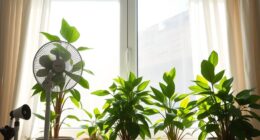To turn on grow lights for your indoor plants, you’ll want to consider their specific light needs. Most plants thrive with 8 to 10 hours of light daily, and adjustments should be made based on their growth stage. Seedlings need longer light durations, while flowering plants benefit from shorter exposure. Position your lights correctly, ideally 12-24 inches above your plants, to prevent stretching and stress. There’s more to discover about optimal conditions for your plants’ health!
Key Takeaways
- Turn on grow lights when natural sunlight is insufficient, particularly during winter months or for low-light plants like ferns.
- Maintain a consistent lighting schedule, ideally 8 to 10 hours daily, to promote healthy plant growth.
- Use timers to automate lighting, ensuring plants receive the necessary light without human error.
- Adjust light intensity and duration based on the plant’s growth stage, with seedlings needing more hours than flowering plants.
- Monitor plants for signs of stress and adjust light timing or intensity accordingly to prevent light burn or insufficient exposure.
Understanding Plant Light Requirements
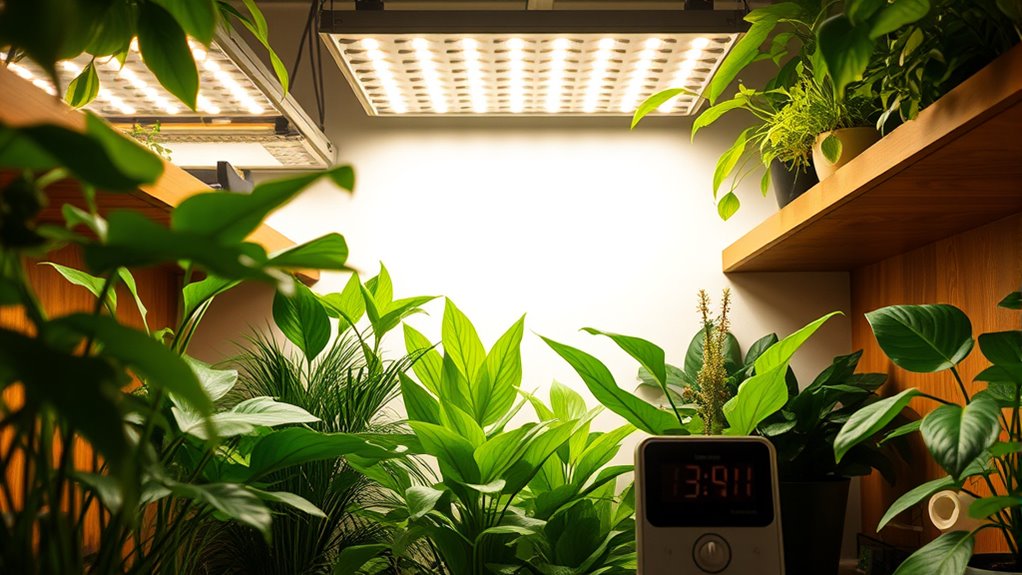
When it comes to growing healthy indoor plants, understanding their light requirements is essential. Different plants need different light intensities; for instance, succulents thrive in bright light, while ferns prefer low light. You should also consider light quality—blue light supports vegetative growth, and red light encourages flowering. Natural sunlight provides a full spectrum, but if you’re using artificial lights like LEDs, ensure they mimic this spectrum. Grow lights produce light particles recognized by plants for photosynthesis, making them a crucial addition to indoor gardening. Additionally, just as color accuracy affects image quality in projectors, the right light spectrum can significantly influence plant health. To enhance your indoor gardening experience, consider using self-watering planters that help maintain consistent moisture levels for your plants. Furthermore, using best watering pots can ensure that your plants receive the right amount of hydration without overwatering. Position grow lights about 1 foot away from your plants to maximize absorption. Keep in mind that window orientation matters; south-facing windows offer the most intense light.
Determining the Ideal Duration of Light

Knowing how much light your plants need is just the beginning; determining the ideal duration of that light is equally important for their growth. Most plants thrive with 8 to 10 hours of light daily, but they shouldn’t exceed 18 hours. Additionally, using portable camping toilets can help maintain a clean environment while tending to your plants. Remember, plants require at least 6 hours of darkness each day to rest and carry out essential metabolic functions. The intensity of light can speed up growth but be cautious to avoid heat stress or light burn. Different species and growth stages have varying light requirements, so adjust accordingly based on DLI needs. It’s crucial to consider the seasonal growth patterns of your plants, as this can significantly affect their light duration needs. In New England, the seasonal variations can also influence the amount of natural light available for your indoor plants. Using timers helps maintain a consistent schedule, mimicking natural light cycles.
Determining the right light duration is crucial; most plants need 8 to 10 hours daily without exceeding 18 hours.
Regularly monitor your plants’ response to ensure you’re providing the optimal light duration for their health and development.
Adjusting Light Based on Growth Stage

As your plants progress through their growth stages, adjusting the light they receive is crucial for their development.
During the seedling stage, provide 14 to 18 hours of blue light, keeping lights 2-4 inches away for higher intensity. This is important because the blue wavelength promotes leafy, green growth, which is essential for establishing roots and initial leaf development. Additionally, high protein levels in plants can be influenced by optimal light exposure, enhancing their overall health and growth. Using natural light sources can also be beneficial during this stage to supplement artificial lighting. Incorporating high fiber options in your plant care, like compost, can also support robust growth.
For vegetative growth, reduce light duration to 12-16 hours, maintaining a balanced spectrum that supports leaf and stem development.
In the flowering stage, decrease light to 8-12 hours, focusing on red and far-red spectrums to enhance flower and fruit production.
Always monitor your plants for signs of stress or insufficient light, and adjust the distance and intensity as needed to ensure they thrive throughout their journey. Tailoring light is essential for optimal growth at every stage.
The Importance of Light Spectrum

Light spectrum plays a crucial role in your plants’ growth and overall health, influencing everything from leaf development to flowering.
Photosynthetically Active Radiation (PAR) ranges from 400-700 nm and is vital for photosynthesis. Blue light (400-500 nm) encourages vegetative growth and leaf development, while red light (600-700 nm) supports flowering and fruiting. Proper light spectrum balance is essential for different growth stages to ensure optimal plant health and productivity. Additionally, utilizing wood pellet fireplaces can provide a controlled environment that promotes consistent light exposure for indoor plants. The use of essential oils can also enhance the overall atmosphere in your indoor gardening space, promoting a more pleasant environment for both plants and caretakers. Regular air purifier maintenance can further improve air quality, benefiting plant growth.
Photosynthetically Active Radiation (PAR) is essential for plant growth, with blue light promoting leaf development and red light enhancing flowering.
Although green light isn’t absorbed as well by chlorophyll, it still contributes to plant health. A balanced, full-spectrum light mimics natural sunlight, catering to both vegetative and flowering stages.
Customizable LED lights can provide tailored spectrums to meet specific plant needs, enhancing growth, yield, and quality.
Understanding these light requirements is essential for maximizing your indoor garden’s potential.
Positioning and Distance for Optimal Growth
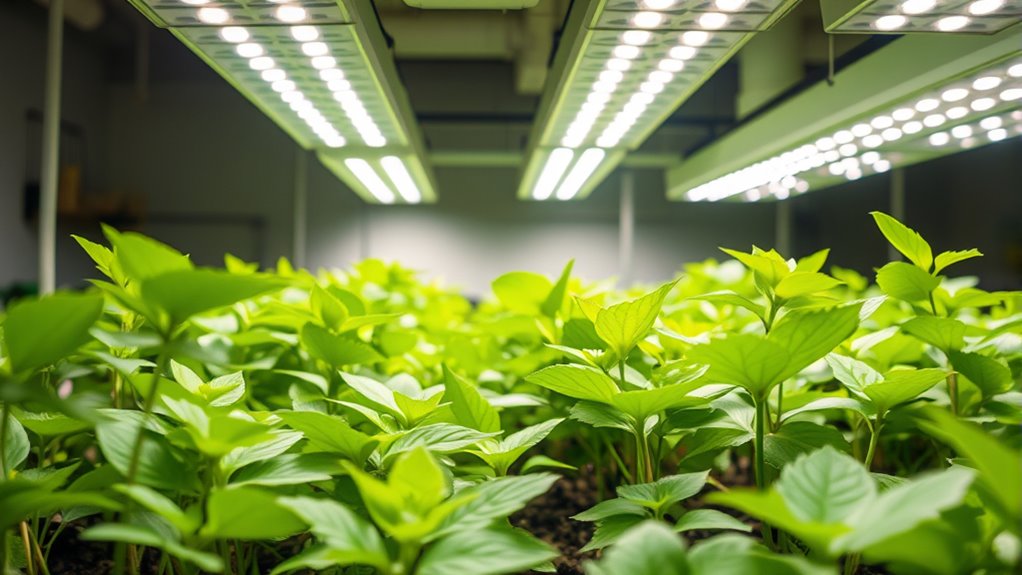
Achieving the right positioning and distance for your grow lights significantly impacts your plants’ growth and health. Generally, most grow lights should be 12-24 inches above your plants.
High-light plants, like tomatoes, need closer placement, while low-light plants, like ferns, require more distance. Adjust the height based on your plants’ growth stages: seedlings thrive with closer lights to prevent stretching, while mature plants may need distance adjustments. Proper height ensures optimal light exposure for all stages of growth. Additionally, consider the importance of selecting the right type of grow light, as different plants may require specific light spectrums for their best growth. Larger plants, such as extra-large houseplants, often need more light due to their increased leaf surface area. Including high-fiber foods like chia seeds in your diet can further support your overall wellness and energy levels while gardening.
Monitor temperature, as closer lights can cause heat stress. Always check manufacturer guidelines for specific recommendations.
Use reflective materials to enhance light distribution and regularly observe your plants for signs of light burn or insufficient light. This proactive approach will help ensure optimal growth.
Automation: Using Timers for Consistency
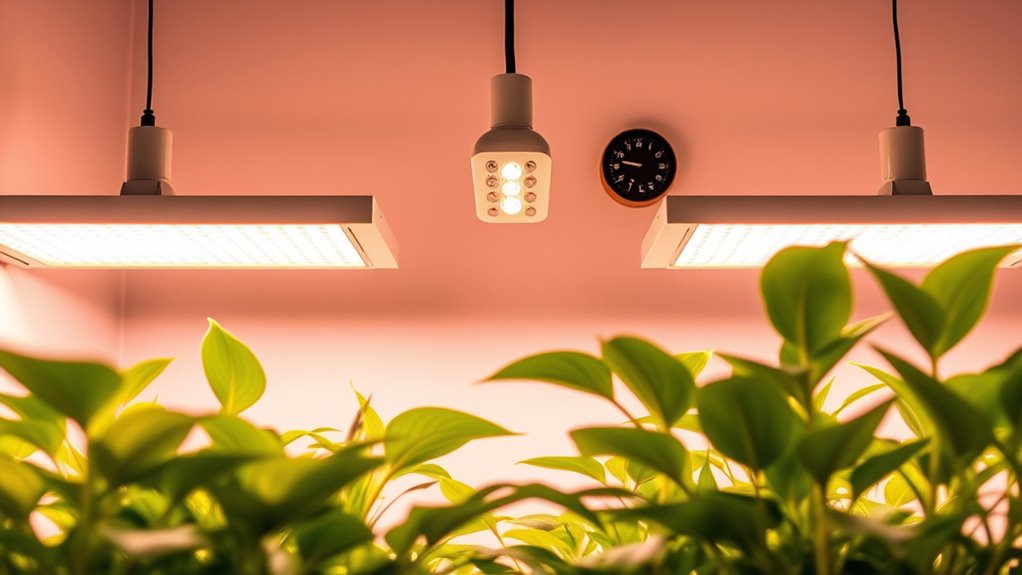
To ensure your indoor plants receive the right amount of light, using timers can streamline your lighting schedule and eliminate the guesswork. Timers automate light cycles, reducing human error and keeping your plants on a consistent schedule. You can choose from basic timers or smart timers that you control via apps for added flexibility. Many timers include features like photocells, which can automate fans and CO2 generators. Additionally, maintaining a consistent lighting schedule is vital for maximizing plant health, similar to how air purifiers optimize air quality for well-being. Appliances Connection and other retailers offer a range of timers that cater to different gardening needs.
In relationships, just as with plants, emotional availability can significantly impact growth and health. Depending on your grow room size, opt for a timer with 1-10 outlets. Programmable timers enable you to set specific days and hours for lighting, ensuring your plants thrive through different growth stages. Consistent light periods are essential for fostering healthier plants while optimizing energy use—making indoor gardening simpler and more efficient.
Frequently Asked Questions
Can I Use Regular Bulbs Instead of Grow Lights?
You can use regular bulbs temporarily for plant growth, but they won’t provide optimal results.
Regular bulbs lack the full spectrum and intensity that plants need to thrive. If you’re hoping for healthy, vibrant plants, it’s better to invest in grow lights designed specifically for this purpose.
However, if you’re in a pinch, some full-spectrum LEDs can work, just make sure they meet the necessary requirements for your plants.
How Do I Know if My Plants Are Getting Enough Light?
Think of your plants as sunbathers yearning for rays; you can tell if they’re getting enough light by observing their leaves.
If they’re yellowing or stretching towards the light, they’re signaling a need for more. Monitor their growth patterns too—slow growth can indicate insufficient light.
Use a light meter for precise measurements, and remember that different plants have unique light needs.
Adjust your setup based on these signs for optimal health.
What Happens if I Leave Grow Lights on Too Long?
If you leave grow lights on too long, your plants might suffer from stress and damage.
You could notice leaf burn, chlorosis, or stunted growth, which all indicate excessive light exposure. Continuous lighting can also disrupt hormone synthesis, leading to premature flowering.
Additionally, the increased energy consumption can raise your costs and contribute to environmental issues.
Keep an eye on your plants to ensure they thrive without being overwhelmed by light.
Are There Specific Grow Lights for Different Plant Types?
Absolutely! Choosing the right grow lights can be crucial for cultivating your plants’ success.
Full sun plants thrive under fierce fixtures, while high light plants prefer a strong setup. Medium light plants appreciate a balanced brightness, and low light plants can flourish with more distant illumination.
Don’t forget specialized lighting for specific needs, like red for flowering or blue for leafy growth. Tailor your lights to match your plants for optimal growth!
How Can I Reduce Energy Costs While Using Grow Lights?
To reduce energy costs while using grow lights, consider switching to energy-efficient LED lights. They consume less power and last longer than traditional options.
Use timers to automate light cycles, ensuring they’re only on when needed. Adjust the intensity based on your plants’ needs, and monitor their response to optimize usage.
Placing lights at the right distance and leveraging natural light can further cut down on energy expenses.
Conclusion
In conclusion, knowing when to turn on grow lights can transform your indoor garden. You might think it’s too complicated, but with just a bit of understanding about your plants’ needs and some simple adjustments, you’ll create the perfect environment for growth. Don’t let uncertainty hold you back—embrace the process and watch your plants thrive! By using timers and positioning your lights correctly, you’ll ensure your plants get the consistent care they deserve.


